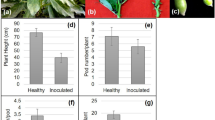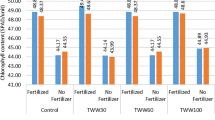Abstract
Though mulberry (Morus alba) tree shows great adaptations to various climate conditions, their leaf water status and photosynthesis are sensitive to climate changes. In the current study, seven widely planted mulberry cultivars in Chongqing, Southwest China, were selected to analyze leaf cuticular wax characteristics, gas exchange index, post-harvest leaf water status and their relationships, aiming to provide new theory in screening high resistant mulberry cultivars. Mulberry trees formed rounded cap-type idioblasts on the adaxial leaf surface. Film-like waxes and granule-type wax crystals covered leaf surfaces, varying in crystal density among cultivars. The stomatal aperture on the abaxial surface of cultivars with high wax amount was smaller than that of cultivars with low wax amount. The amount of total wax was negatively correlated with the net photosynthetic rate (P N), transpiration rate (E) and stomatal conductance (g s) and positively correlated with the moisture retention capacity. It suggested that both cuticular wax and stomatal factor might be involved in regulating water loss in mulberry leaves under field conditions. The variability in moisture retention capacity and cuticular wax characteristics might be important in evaluating and screening mulberry cultivars for increasing silk quality and silkworm productivity.






Similar content being viewed by others
References
Aasamaa K, Sober A (2011) Responses of stomatal conductance to simultaneous changes in two environmental factors. Tree Physiol 31:855–864
Agrawal AA, Fishbein M, Jetter R, Salminen JP, Goldstein JB, Freitag AE, Sparks JP (2009) Phylogenetic ecology of leaf surface traits in the milkweeds (Asclepias spp.): chemistry, ecophysiology, and insect behavior. New Phytol 183:848–867
Bauer P, Elbaum R, Weiss IM (2011) Calcium and silicon mineralization in land plants: transport, structure and function. Plant Sci 180:746–756
Bengtson C, Larsson S, Liljenberg C (1978) Effects of water stress on cuticular transpiration rate and amount and composition of epicuticular wax in seedlings of 6 oat varieties. Physiol Plant 44:319–324
Cameron KD, Teece MA, Bevilacqua E, Smart LB (2002) Diversity of cuticular wax among Salix species and Populus species hybrids. Phytochem 60:715–725
Cameron KD, Teece MA, Smart LB (2006) Increased accumulation of cuticular wax and expression of lipid transfer protein in response to periodic drying events in leaves of tree tobacco. Plant Physiol 140:176–183
Figueiredo KV, Oliveira MT, Oliveira AFM, Silva GC, Santos MG (2012) Epicuticular-wax removal influences gas exchange and water relations in the leaves of an exotic and native species from a Brazilian semiarid region under induced drought stress. Aus J Bot 60:685–692
Flexas J, Medrano H (2002) Drought-inhibition of photosynthesis in C-3 plants: stomatal and non-stomatal limitations revisited. Ann Bot 89:183–189
Gonzalez A, Ayerbe L (2010) Effect of terminal water stress on leaf epicuticular wax load, residual transpiration and grain yield in barley. Euphytica 172:341–349
Guha A, Reddy AR (2014) Leaf gas exchange, water relations and photosystem-II functionality depict anisohydric behavior of drought-stressed mulberry (Morus indica, cv. V1) in the hot semi-arid steppe agroclimate of Southern India. Flora Morphol Distr Funct Eco Plants 209:142–152
Gulz PG (1994) Epicuticular leaf waxes in the evolution of the plant kingdom. J Plant Physiol 143:453–464
Guo YJ, Ni Y, Guo YJ, Han L, Tang H (2011) Effects of air humidity and soil water deficit on characteristics of leaf cuticular waxes in alfalfa (Medicago staiva). Acta Ecol Sin 31:5273–5280 (in Chinese)
Holroyd GH, Hetherington AM, Gray JE (2002) A role for the cuticular waxes in the environmental control of stomatal development. New Phytol 153:433–439
Huang XH, Liu Y, Li JX, Xiong XZ, Chen YH, Yin XH, Feng DL (2013) The response of mulberry trees after seedling hardening to summer drought in the hydro-fluctuation belt of Three Gorges Reservoir Areas. Environ Sci Pollut Res 20:7103–7111
Jefferson PG, Johnson DA, Rumbaugh MD, Asay KH (1989) Water stress and genotypic effects on epicuticular wax production of alfalfa and crested wheatgrass in relation to yield and excised leaf water loss rate. Can J Plant Sci 69:481–490
Jordan WR, Shouse PJ, Blum A, Miller FR, Monk RL (1984) Environmental physiology of sorghum. 2. Epicuticular wax load and cuticular transpiration. Crop Sci 24:1168–1173
Khurana P, Checker VG (2011) The advent of genomics in mulberry and perspectives for productivity enhancement. Plant Cell Rep 30:825–838
Kim KS, Park SH, Jenks MA (2007) Changes in leaf cuticular waxes of sesame (Sesamum indicum L.) plants exposed to water deficit. J Plant Physiol 164:1134–1143
Koch K, Ensikat HJ (2008) The hydrophobic coatings of plant surfaces: epicuticular wax crystals and their morphologies, crystallinity and molecular self-assembly. Micron 39:759–772
Koch K, Hartmann KD, Schreiber L, Barthlott W, Neinhuis C (2006) Influences of air humidity during the cultivation of plants on wax chemical composition, morphology and leaf surface wettability. Environ Exp Bot 56:1–9
Kosma DK, Bourdenx B, Bernard A, Parsons EP, Lu S, Joubes J, Jenks MA (2009) The impact of water deficiency on leaf cuticle lipids of Arabidopsis. Plant Physiol 151:1918–1929
Kottapalli KR et al (2009) Physiology and proteomics of the water-deficit stress response in three contrasting peanut genotypes. Plant Cell Environ 32:380–407
Majada JP, Sierra MI, Sanchez-Tames R (2001) Air exchange rate affects the in vitro developed leaf cuticle of carnation. Scientia Hort 87:121–130
Mamrutha HM et al (2010) Leaf cuticular wax amount and crystal morphology regulate post-harvest water loss in mulberry (Morus species). Plant Physiol Biochem 48:690–696
Mohammadian MA, Watling JR, Hill RS (2007) The impact of epicuticular wax on gas-exchange and photoinhibition in Leucadendron lanigerum (Proteaceae). Acta Oecol Int J Ecol 31:93–101
Nautiyal PC, Raigopal K, Zala PV, Pujari DS, Basu M, Dhadhal BA, Nandre BM (2008) Evaluation of wild Arachis species for abiotic stress tolerance: I. Thermal stress and leaf water relations. Euphytica 159:43–57
Ni Y, Xia RE, Li JN (2014) Changes of epicuticular wax induced by enhanced UV-B radiation impact on gas exchange in Brassica napus. Acta Physiol Plant 36:2481–2490
Nitta I, Kida A, Fujibayashi Y, Katayama H, Sugimura Y (2006) Calcium carbonate deposition in a cell wall sac formed in mulberry idioblasts. Protoplasma 228:201–208
Oliveira AFM, Meirelles ST, Salatino A (2003) Epicuticular waxes from caatinga and cerrado species and their efficiency against water loss. An Acad Bras Cien 75:431–439
O’Toole JC, Cruz RT, Seiber JN (1979) Epicuticular wax and cuticular resistance in rice. Physiol Plant 47:239–244
Reddy AR, Chaitanya KV, Jutur PP, Sumithra K (2004) Differential antioxidative responses to water stress among five mulberry (Morus alba L.) cultivars. Environ Exp Bot 52:33–42
Samdur MY, Manivel P, Jain VK, Chikani BM, Gor HK, Desai S, Misra JB (2003) Genotypic differences and water-deficit induced enhancement in epicuticular wax load in peanut. Crop Sci 43:1294–1299
Sugimura Y et al (1999) Calcium deposition in idioblasts of mulberry leaves. Ann Bot 83:543–550
Yang J, Ordiz MI, Jaworski JG, Beachy RN (2011) Induced accumulation of cuticular waxes enhances drought tolerance in Arabidopsis by changes in development of stomata. Plant Physiol Biochem 49:1448–1455
Yeats TH, Rose JKC (2013) The formation and function of plant cuticles. Plant Physiol 163:5–20
Acknowledgments
This work was funded by the National Natural Science Foundation of China (31270450). The authors are grateful to Lv Jun and Zheng Jun for their assistance in measuring photosynthesis and cuticular waxes.
Author information
Authors and Affiliations
Corresponding author
Additional information
Communicated by U. Feller.
Electronic supplementary material
Below is the link to the electronic supplementary material.





Rights and permissions
About this article
Cite this article
Ni, Y., Sun, Z., Huang, X. et al. Variations of cuticular wax in mulberry trees and their effects on gas exchange and post-harvest water loss. Acta Physiol Plant 37, 112 (2015). https://doi.org/10.1007/s11738-015-1856-1
Received:
Revised:
Accepted:
Published:
DOI: https://doi.org/10.1007/s11738-015-1856-1




